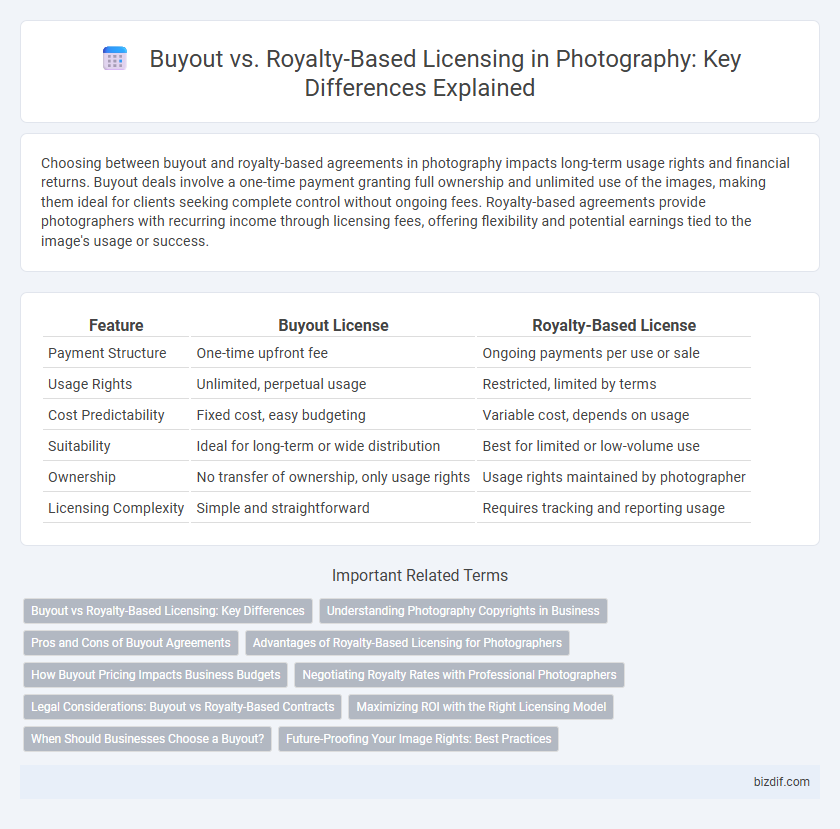Choosing between buyout and royalty-based agreements in photography impacts long-term usage rights and financial returns. Buyout deals involve a one-time payment granting full ownership and unlimited use of the images, making them ideal for clients seeking complete control without ongoing fees. Royalty-based agreements provide photographers with recurring income through licensing fees, offering flexibility and potential earnings tied to the image's usage or success.
Table of Comparison
| Feature | Buyout License | Royalty-Based License |
|---|---|---|
| Payment Structure | One-time upfront fee | Ongoing payments per use or sale |
| Usage Rights | Unlimited, perpetual usage | Restricted, limited by terms |
| Cost Predictability | Fixed cost, easy budgeting | Variable cost, depends on usage |
| Suitability | Ideal for long-term or wide distribution | Best for limited or low-volume use |
| Ownership | No transfer of ownership, only usage rights | Usage rights maintained by photographer |
| Licensing Complexity | Simple and straightforward | Requires tracking and reporting usage |
Buyout vs Royalty-Based Licensing: Key Differences
Buyout licensing grants photographers a one-time payment for full ownership rights, allowing unlimited use of images without ongoing fees. Royalty-based licensing requires recurring payments based on usage frequency or duration, maintaining the photographer's copyright. Buyout offers cost certainty for clients, while royalty-based provides ongoing revenue streams for photographers.
Understanding Photography Copyrights in Business
Buyout licenses grant photographers a one-time fee for complete ownership transfer of image rights, allowing businesses unlimited use and modifications without ongoing payments. Royalty-based licenses require businesses to pay royalties each time the image is used, often calculated per use or time period, providing limited or specific usage rights. Understanding the differences between buyout and royalty-based copyrights ensures companies comply with legal requirements while optimizing costs in their photography licensing strategy.
Pros and Cons of Buyout Agreements
Buyout agreements in photography provide clients with full ownership rights of the images after a one-time payment, eliminating ongoing royalty fees and simplifying future usage. This model ensures photographers receive immediate, upfront compensation but may limit their earnings potential if the images are used extensively or generate high revenue over time. The lack of residual income can be a disadvantage for photographers, while clients benefit from clear usage rights without the complexity of tracking royalties.
Advantages of Royalty-Based Licensing for Photographers
Royalty-based licensing provides photographers with ongoing revenue streams by earning a percentage each time their images are used, ensuring income growth aligned with the image's popularity. This model encourages continued control over the work and allows photographers to capitalize on long-term value rather than a one-time payment. Royalty-based agreements can also enhance market exposure and build a sustainable professional portfolio by enabling repeated licensing to various clients.
How Buyout Pricing Impacts Business Budgets
Buyout pricing in photography requires a one-time payment for unlimited use of images, which provides businesses with predictable budgeting and eliminates ongoing royalty fees. This model allows companies to allocate fixed costs upfront, avoiding fluctuating expenses associated with royalty-based licensing that depends on usage volume or duration. As a result, buyout pricing can improve financial planning and cash flow management by reducing the complexity of tracking and paying royalties over time.
Negotiating Royalty Rates with Professional Photographers
Negotiating royalty rates with professional photographers requires understanding industry standards typically ranging from 10% to 50% of sales, depending on usage rights and exclusivity. Clear agreements on royalty duration, geographic scope, and permitted media ensure fair compensation and protect both parties' interests. Emphasizing transparency and flexibility during negotiations fosters long-term collaboration and maximizes value from photographic assets.
Legal Considerations: Buyout vs Royalty-Based Contracts
Buyout contracts grant photographers full ownership rights of their images to clients, eliminating future royalties but requiring clear terms on usage and exclusivity to avoid legal disputes. Royalty-based agreements allow photographers to retain copyright, ensuring ongoing payments each time the image is used, which demands precise tracking of usage and licensing scopes in the contract. Understanding these legal distinctions is critical for photographers to safeguard intellectual property and establish fair compensation frameworks.
Maximizing ROI with the Right Licensing Model
Choosing between buyout and royalty-based licensing models directly impacts a photographer's return on investment (ROI). Buyout licenses provide a one-time payment granting full usage rights, ideal for maximizing upfront revenue and simplifying contract management. Royalty-based licenses generate ongoing income tied to the photo's usage or sales volume, which can lead to higher long-term earnings for high-demand images with sustained exposure.
When Should Businesses Choose a Buyout?
Businesses should choose a buyout model when they require unlimited, long-term usage rights for images without ongoing fees, ensuring budget predictability and simplified licensing management. Buyouts are ideal for marketing campaigns, product packaging, or website content where the image will be used repeatedly or across multiple platforms. This one-time payment approach eliminates future royalty tracking and grants full control over the photograph's use.
Future-Proofing Your Image Rights: Best Practices
Securing buyout agreements ensures complete ownership of image rights, eliminating future licensing complications and enabling unrestricted commercial use. Royalty-based models provide ongoing revenue streams but may require renegotiation as usage evolves, potentially limiting long-term flexibility. Future-proofing image rights involves clear contract terms outlining usage scope, duration, and transferability to protect against market changes and technology advancements.
Buyout vs Royalty-Based Infographic

 bizdif.com
bizdif.com